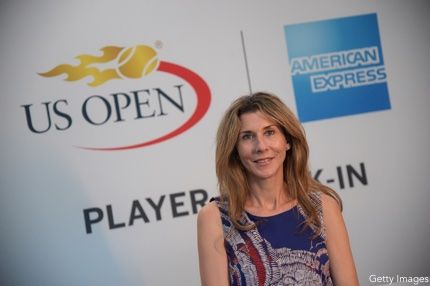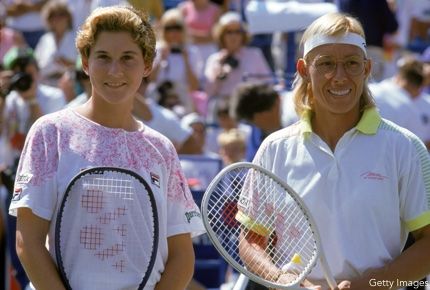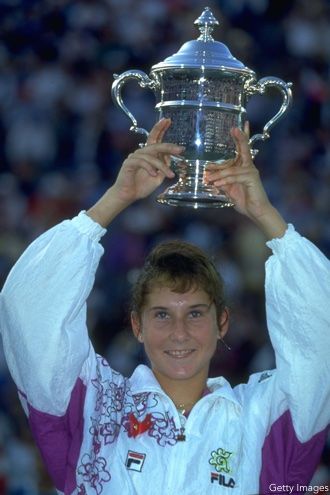Monica Seles is at Day 1 of the U.S. Open. Now 14 years removed from the draw, she wears a multi-colored dress and flats. She is calm and engaging and blends in like most Flushing fans.
Hidden beneath that exterior is an athlete won nine career Grand Slams (including two U.S. Opens), climbed to World No. 1 at age 17, and suffered one of the most harrowing moments in sports history.
A conversation starts about Seles' decision to represent the U.S. in 1995 over her native Yugoslavia. Seles' first Grand Slam back from a two-year hiatus was at the U.S. Open that August.
"I think a lot of people who really never played tennis knew me for my stabbing," she says. "The welcome I received from here was so reassuring that I made the right decision because you never know, I am a human being too and I second guess decisions after two plus years being away, and those ages were the prime years."
Seles brings up her near-death experience like it is casual memory. In 1993, during a match in Hamburg, a Steffi Graf-obsessed fan charged onto the court and stabbed Seles, 0.59 inches deep into her back. At the time, Seles was the World No. 1 and had won seven of the past nine Grand Slams. Seles' wounds healed within a few weeks, but she stayed out of tennis for over two years.
In 2016, Seles has perspective on the moment the tennis world held its breath.
"No, I mean, it is part of your life," she says when asked if she gets sick of stabbing questions. "One thing in tennis that I learned, and I say this to young kids in juniors, you need to deal with the positives and negatives yourself. It is just you out there on the court, and you only get to have somebody travel with you if you're a top player because economically, you can't pay your coach and trainer.
"Only the top 10 players can, so you learn to kind of deal with you own emotions when you win and lose and the same thing I think in life. We all have some years, some days better, and some years, some days worse. And I am very happy that tennis has given me that inner strength, and essentially, I look at it as not many people can have a passion and make a living at it."
Seles moved to the United States when she was 12, and attained U.S. citizenship in 1994 after her stabbing. With Chris Evert retiring in 1989 and Martina Navratilova in 1994, Seles instantly became the face of American tennis upon her 1995 return.
"I remember playing Martina here at my first finals that I actually did win," Seles says, referring to 1991. "I don't know how many Louis Armstrong [Stadium] held, but I am not exaggerating, there were no more than 50 people rooting for me and the rest were for Martina. But thankfully, when I came back, I experienced it the other way around, where the stadium was for me and it sure is a lot better when the New York fans are for you instead of booing you."
Seles came back with a boom. She made the 1995 U.S. Open final, but lost to Graf. Despite the American crowd support, Déjà vu kicked in a year later, as Graf again defeated Seles in the 1996 final. Seles did find a way to win the 1996 Australian Open, but that would be her ninth and final Grand Slam.

Seles stuck around through 2003, but never recaptured her teenage form. From 1998 Wimbledon to the the 2002 U.S. Open, Seles reached 13 quarterfinals in 15 Grand Slams she played. Three times, she stretched that to a semifinal appearance. But after the 1998 French Open, Seles never again returned to a Grand Slam final. She handed off her short-lived American torch to the Williams Sisters-Lindsay Davenport-Jennifer Capriati generation.
Seles was 29 years old when she played her final competitive match. In 2003, there was no shame at calling quits at such an age. In 2016, Seles chuckles at the fact the best players continue to compete at a high level deep into their thirties.
"They really love to play," she says. "It is almost like a drug in a way. When they go, like in Roger [Federer]'s case or [Rafael] Nadal or Serena [Williams], they are breaking records or setting new records. You are making history. Not many of us get to do that. And if your body is allowing it today with all the different nutrition forms, I think the players are able to play longer.
My generation was 28 or 30, then retire. Now, think 35 and you look at Serena, and she looks great. I wouldn't know if she is 30 or 35 the way she moves."
Williams will turn 35 on Sept. 26. She has been the World No. 1 since Feb. 18, 2013, her sixth run at the top.
Seles' final week at World No. 1 was from Nov. 18-Nov. 24, sharing the title with Graf. Seles says it is pointless to compare players of different generations, but she can imagine how her career would be different in this current form of the game.

"I like that the tour is a bit shorter now by about two months," she says. "I think that is a smart decision. For my generation, it was just too long, just too much tennis on the body. I think it is good that there are less junior tournaments. But also tennis is more like an event with the social media. Before, it was more tennis. In the old U.S. Open, the locker rooms were nothing like they are now.
"Now, everything is luxurious, everything is an experience."
Seles had the chance to experience the American Express "Pro Walk" at the USTA Billie Jean King National Tennis Center. Walking through the virtual tour, Seles is able to re-imagine herself walking into Arthur Ashe Stadium.
"A few years ago I got to play with John McEnroe before Wimbledon," she says. Today, I get to see a hologram of myself and experience 20,000 people cheering for me. When I think about it later on in my life, these experiences are super cool."
Seles appears relaxed back in the spotlight. The American Express building at the U.S. Open is lined with photos of her youth (and Pete Sampras, also part of the AMEX partnership). Yet Seles does not feel smothered by the most-attended annual sporting event in the world.
"I've been walking around the grounds and it has been great," she says. "But I am retired. It is different when you're retired. If you had Roger Federer, it would be very different."
Today, Monica Seles looks like an ordinary U.S. Open fan. But beneath that, she is still the ultra-competitive, bold tactician that once upon a time, was one of tennis' greatest talents. A stabbing 23 years ago hindered that spirit, but did not kill it.
-- Follow Jeffrey Eisenband on Twitter @JeffEisenband.






